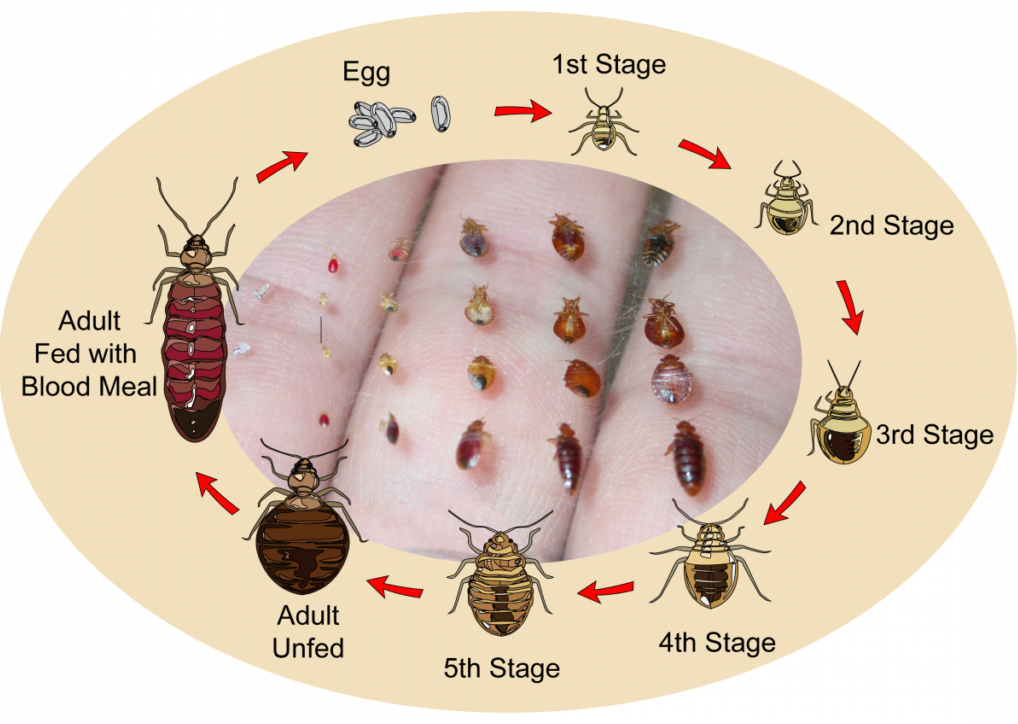Introduction To Bed Bugs
Finding a fly buzzing around your house isn’t that uncommon. Noticing a spider or lady bug can be pretty normal, too. But bed bugs are another story. When you see one, you can almost guarantee that more are hiding. Learning more about what you’re up against—and how to get rid of bed bugs—will help you keep the problem from getting any worse. After all, knowledge is power.
What do bed bugs look like?
Adult bed bugs are about 5 mm in length. Females are elongated and have similar shape and color to an apple seed, while adult males have similar size and outline of an adult lady bug. Juvenile bed bugs, called nymphs, are similar in size, shape and color to sesame seeds. As nymphs develop they will shed their exoskeleton several times before reaching maturity. It is common to find these shed exoskeletons in larger infestations.

Although small, even bed bug eggs can be seen with the naked eye. Bed bug eggs are about the size of the tip of a medium ball-point pen and are typically a light sesame seed color. There are several insects that are commonly mistaken for bed bugs, like the varied carpet beetle. If you have a specimen, simply snap a clear picture and email it to us for positive identification.
Why are bed bugs a problem?
Like mosquitos, bed bugs consume blood. They don’t eat anything else. Their bites can be extremely irritating, red, and itchy. Some people have severe allergic reactions resulting from bed bug bites. So, although bed bugs don’t carry diseases, they’re still considered a public health pest. Left untreated, bed bugs are notoriously prolific and they can spread rapidly. Bed bugs are also extremely distressing. It’s not uncommon to experience anxiety, paranoia, stress or even insomnia when dealing with bed bugs.
Bed bugs are also extremely distressing. It’s not uncommon to experience anxiety, paranoia, stress or even insomnia when dealing with bed bugs.
Bed bugs can also have a dramatic economic impact for property owners who can experience increased vacancy rates resulting from infestations. Costs for management of many apartment complexes and subsidized housing have increased substantially since the resurgence of bed bugs.
How do I know if I have bed bugs?
Bed bugs are extremely efficient at finding places to hide where they are almost impossible to find. Finding live bed bugs is not always realistic, so familiarizing yourself with other traces they leave behind will be critical in determining if bed bugs are present.
Aside from finding bites on your body, you might notice fecal spotting, which appears as strange rust-colored stains on your sheets or mattress. Bed bug fecal spotting will look like small polka dots from a fine-point permanent marker. Fecal spotting can be seen anywhere between where the bugs are feeding and the space where they are hiding.
Shed exoskeletons can be found anywhere bed bugs have trafficked, but they are commonly found along baseboards, bed frames, and mattress folds
There are five stages of growth between a bed bug egg and a mature adult. In between each stage, bed bugs will shed their exoskeleton leaving behind a small piece of evidence. Shed exoskeletons can be found anywhere bed bugs have trafficked, but they are commonly found along baseboards, bed frames, and mattress folds. These can be some of the more obvious bed bug signs.
How do I know if I have bed bugs?
Because bed bugs can hide in tough-to-reach places, like wall voids or inside picture frames, you need a treatment regimen that will be thorough enough to kill bed bugs wherever they may be hiding. Oftentimes, a DIY process isn’t enough to tackle the problem. Even professional services that only use sprays to treat bed bugs are only marginally effective, because there are no sprays that kill bed bug eggs. Some sprays advertise that they can kill bed bug eggs, but this is in laboratory tests where eggs can be individually sprayed. This situation is not practical in real-world situations because it is physically impossible to treat every bed bug egg in a treatment setting.
Heat Treatment the best way to get rid of Bed Bugs!
This is why heat is the best way to get rid of bed bugs. When the ambient air temperature is hot enough, bed bugs in every life stage will die, including their eggs. All stages of bed bug life will die at around 120 degrees Fahrenheit.
Custom Bedbug uses specialized heaters to raise and maintain temperatures to a level that ensures eradication of all bed bugs. In conjunction with the heat, a spray and dust application ensures residual protection against future infestations.
Heat Treatment is the best way to fight a Bed Bug infestation.
DIY Tips to help you succeed at fighting Bed Bug yourself


